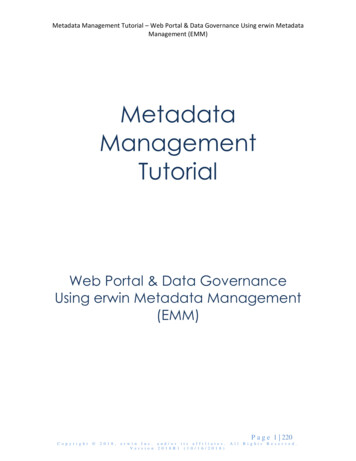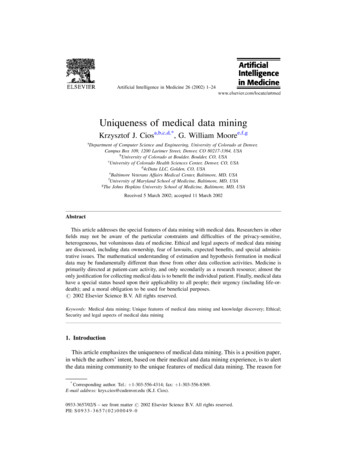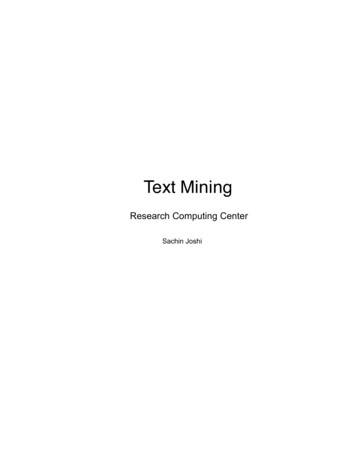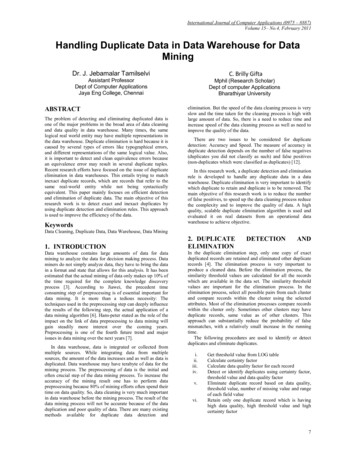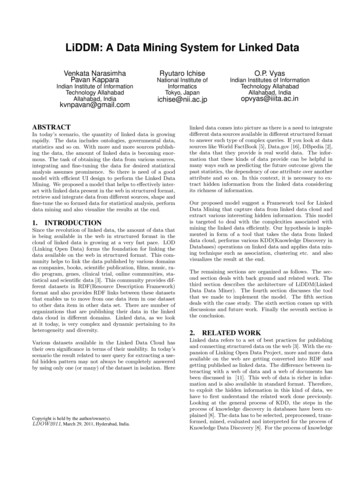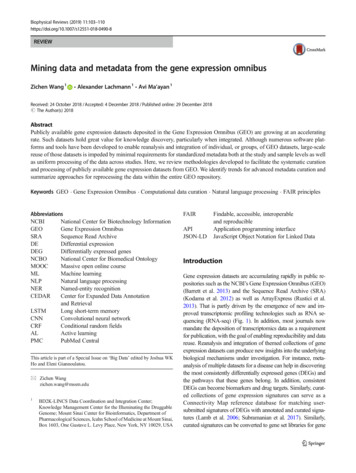
Transcription
Biophysical Reviews (2019) 0-8REVIEWMining data and metadata from the gene expression omnibusZichen Wang 1&Alexander Lachmann 1 & Avi Ma’ayan 1Received: 24 October 2018 / Accepted: 4 December 2018 / Published online: 29 December 2018# The Author(s) 2018AbstractPublicly available gene expression datasets deposited in the Gene Expression Omnibus (GEO) are growing at an acceleratingrate. Such datasets hold great value for knowledge discovery, particularly when integrated. Although numerous software platforms and tools have been developed to enable reanalysis and integration of individual, or groups, of GEO datasets, large-scalereuse of those datasets is impeded by minimal requirements for standardized metadata both at the study and sample levels as wellas uniform processing of the data across studies. Here, we review methodologies developed to facilitate the systematic curationand processing of publicly available gene expression datasets from GEO. We identify trends for advanced metadata curation andsummarize approaches for reprocessing the data within the entire GEO repository.Keywords GEO . Gene Expression Omnibus . Computational data curation . Natural language processing . FAIR principlesAbbreviationsNCBINational Center for Biotechnology InformationGEOGene Expression OmnibusSRASequence Read ArchiveDEDifferential expressionDEGDifferentially expressed genesNCBONational Center for Biomedical OntologyMOOCMassive open online courseMLMachine learningNLPNatural language processingNERNamed-entity recognitionCEDARCenter for Expanded Data Annotationand RetrievalLSTMLong short-term memoryCNNConvolutional neural networkCRFConditional random fieldsALActive learningPMCPubMed CentralThis article is part of a Special Issue on ‘Big Data’ edited by Joshua WKHo and Eleni Giannoulatou.* Zichen Wangzichen.wang@mssm.edu1BD2K-LINCS Data Coordination and Integration Center;Knowledge Management Center for the Illuminating the DruggableGenome; Mount Sinai Center for Bioinformatics, Department ofPharmacological Sciences, Icahn School of Medicine at Mount Sinai,Box 1603, One Gustave L. Levy Place, New York, NY 10029, USAFAIRAPIJSON-LDFindable, accessible, interoperableand reproducibleApplication programming interfaceJavaScript Object Notation for Linked DataIntroductionGene expression datasets are accumulating rapidly in public repositories such as the NCBI’s Gene Expression Omnibus (GEO)(Barrett et al. 2013) and the Sequence Read Archive (SRA)(Kodama et al. 2012) as well as ArrayExpress (Rustici et al.2013). That is partly driven by the emergence of new and improved transcriptomic profiling technologies such as RNA sequencing (RNA-seq) (Fig. 1). In addition, most journals nowmandate the deposition of transcriptomics data as a requirementfor publication, with the goal of enabling reproducibility and datareuse. Reanalysis and integration of themed collections of geneexpression datasets can produce new insights into the underlyingbiological mechanisms under investigation. For instance, metaanalysis of multiple datasets for a disease can help in discoveringthe most consistently differentially expressed genes (DEGs) andthe pathways that these genes belong. In addition, consistentDEGs can become biomarkers and drug targets. Similarly, curated collections of gene expression signatures can serve as aConnectivity Map reference database for matching usersubmitted signatures of DEGs with annotated and curated signatures (Lamb et al. 2006; Subramanian et al. 2017). Similarly,curated signatures can be converted to gene set libraries for gene
104Biophys Rev (2019) 11:103–110Fig. 1 The growth of publiclyavailable gene expression datasetsand samples from GEO over time.Plots on the top panel show thegrowth of gene expressiondatasets from differenttranscriptomic profilingtechnologies over time, whereasplots on the bottom panel showthe growth of individual samplesfrom those datasets. The plotswere made on September 2018.Hence, the total for 2018 coveronly part of the yearset enrichment analyses (Chen et al. 2013; Kuleshov et al. 2016;Subramanian et al. 2005). In addition, curated signatures can becompared for reproducibility across multiple independent studies(Gundersen et al. 2016), or for finding unexpected relationshipsbetween drugs, genes, and diseases (Wang et al. 2016; Chen andButte 2016; Cheng et al. 2014).Several software tools have been developed for reanalyzingindividual or collections of datasets from GEO (Table 1). Thosetools enable users to search GEO for relevant studies and thenretrieve specific datasets for further analysis. In addition to thosetools, approaches have been developed to uniformly reprocessall the microarray or RNA-seq datasets in GEO. The uniformlyreprocessed gene expression datasets can be organized intoTable 1databases that serve as search engines that enable knowledgediscovery at the data level. Prominent examples includeExpressionBlast (Zinman et al. 2013), Recount2 (ColladoTorres et al. 2017), ARCHS4 (Lachmann et al. 2018), andSEEK (Zhu et al. 2015). These resources processed a largenumber of microarray and RNA-seq samples to build searchengines for gene expression profiles and co-expression modules.Recent advances in cloud computing infrastructure, efficientcloud-enabled aligners such as Rail-RNA (Nellore et al. 2017),and alignment-free RNA-seq quantification methods such asKallisto (Bray et al. 2016) enable the large-scale uniformreprocessing of RNA-seq datasets from GEO. Such efforts include Recount2 (Collado-Torres et al. 2017) and ARCHS4Software tools developed for reanalyzing and further annotating GEO datasetsToolCitationIndividual/ TypemultipleNoteLimitationsGEO2R(Barrett et al. 2013)IndividualWebImplements GUI that generate graphsand R scriptshinyGEO(Dumas et al. 2016)IndividualWebR Shiny extension of GEO2Rwith improved graphicsGEOquery(Davis and Meltzer 2007)IndividualR packageGEO2Enrichr(Gundersen et al. 2015)IndividualBioJupies(Torre et al. 2018)IndividualBrowerextensionWebScanGEO(Koeppen et al. 2017)MultipleWebImaGEO(Toro-Domínguez et al. 2018)MultipleWebGEOracle(Djordjevic et al. 2017)MultipleWebBridge between GEO and BioConductorto enable analyses of GEO datasetsin various BioConductor packagesIdentifies DEGs and pipe to enrichmentanalysis toolGenerates interactive Jupyter notebooksfrom RNA-seq datasetsIdentifies DEGs across multiple GEOstudies matching user-specified criteriaPerforms nine types of meta-analysisacross multiple GEO studiesUses text mining of the GEO metadata toautomatically identify perturbationalGEO datasets and associated metadataLimited graphical visualizations;only implements DE analysis;limited to microarray dataDE analysis only available forindividual genes; limited tomicroarray dataRequires users to be proficient in Rand Bioconductor packages;limited to microarray dataLimited to microarray data;limited analysis componentsLimited to RNA-seq data. Onlyallows 2 group comparisonLimited to curated GEO datasets(GDS); only supports DE analysisLimited to microarray datasetsLimited to microarray datasets;only performs DE analysis
Biophys Rev (2019) 11:103–110(Lachmann et al. 2018). These newer search engines provideother features besides sample search, for example, gene functionprediction, average expression in tissues and cells, and systematic discovery of alternative splicing events.However, integrating datasets across studies as well asperforming meta-analyses from collections of studies is stilldifficult. This is mainly because of the lack of machinereadable standardized metadata at the study and sample levels.The metadata associated with gene expression studies withinGEO typically do not adhere to controlled vocabularies to describe biological entities such as tissue type, cell type, cell line,gene/protein, drug/small-molecule, and disease. Instead, the authors of the datasets use semi-structured textual descriptions toannotate their study design, sample characteristics, and experimental protocols. Many GEO studies are also associated withpublications indexed in PubMed, which further helps other researchers to understand the details of each study design, butdoes not resolve the necessity for machine-readable metadata.Therefore, there is an urgent need for better curating andannotating publicly available gene expression datasets at scaleto enable better data reuse that can facilitate new discoveries.The task of curating and annotating GEO datasets involves theidentifying and mapping of biological entities such as genes/proteins, drugs/small-molecules, diseases, and cells/tissuetypes at both the dataset and sample levels. Such mapping needsto be done to relevant community-accepted controlled vocabularies such as specialized ontologies available from the NationalCenter for Biomedical Ontology (NCBO) BioPortal (Whetzelet al. 2011) and other community-accepted naming standards.Better annotation of datasets and samples will provide the basisfor identifying meaningful biological contrasts among groups ofsamples, which can then be used for differential expression (DE)analysis. Here, we review recent advances and future perspectives in the process of curating and reprocessing publicly available gene expression datasets from GEO.Approaches toward improving curationand annotation of GEO metadataMultiple approaches have been developed for improving thecurating of the metadata associated with publicly availablestudies served on the GEO repository. These methods can bebroadly categorized into (1) manual curation, (2) automatednatural language processing (NLP), and (3) inferring metadatadirectly from the gene expression profiles. In the subsequentsections, we describe recent activities within these three categories (Fig. 2).Manual curationAlthough not perfect, manual curation efforts applied to annotate GEO studies yield high-quality results. However, manual105curation does not scale up to cover the tens of thousands ofstudies that are currently available from GEO. Since GEO, andrepositories like it, are expected to drastically grow in the coming years, manual curation is in general not feasible.Crowdsourcing microtasks are projects that consist of a relatively trivial task that requires a large number of participants tocomplete (Good and Su 2013; Khare et al. 2015). Such an approach is one way to scale up manual metadata curation of GEOdatasets. Through a massive open online course (MOOC) onCoursera, we worked together with over 70 participants fromover 25 countries to identify and annotate 2460 single-geneperturbation signatures, 839 disease signatures, and 906 drugperturbation signatures from GEO (Wang et al. 2016). The collections of these signatures are served as a web portal calledCRowd Extracted Expression of Differential Signatures(CREEDS). CREEDS provides the annotated signatures forquery, download, and visualization. A few other similar projectswere launched to curate GEO datasets using microtaskcrowdsourcing strategies. One such project is STARGEO, awebsite that facilitates the curation of GEO samples with diseasephenotypes. The STARGEO project is a manual crowdsourcingcuration effort that recruited graduate students to annotate samples with disease phenotypes (Hadley et al. 2017). Another similar effort called OMics Compendia Commons (OMiCC) (Shahet al. 2016) is a community-oriented framework that enablesbiomedical researchers to collaboratively annotate gene expression datasets and samples. OMiCC is also equipped with a webinterface that lets users perform meta-analyses including differential expression analysis.The manually curated GEO datasets facilitated the reanalysis of multiple related datasets to reveal novel biologicalinsights. For instance, by clustering the curated signaturesfrom genetic perturbation and diseases, we found multiplemyelodysplastic syndrome (MDS) signatures from CD34 cells that cluster with ERBB2 overexpression signatures fromMCF10A cells. Such co-clustering suggests that the upregulation of ERBB2 and related pathways may play a role in MDS(Wang et al. 2016). Another example is the meta-analysis ofinflammatory bowel disease (IBD) signatures across multipleindependent studies, curated by the OMiCC platform. Thisanalysis discovered that several peroxisome proliferatoractivated receptors (PPARs) are lowly expressed in Crohn’sdisease (Shah et al. 2016).While manual curation through crowdsourcing produces,in general, high-quality annotations, this approach has otherdrawbacks besides lack of scalability. Curators make mistakesand produce inconsistent annotations in borderline cases(Good and Su 2013; Khare et al. 2015). While this can beresolved through a double-blinded review process, havingmultiple curators annotate the same datasets increases the burden on the curation task many folds. For the CREEDS project,we had to spot check all entries and remove contributors thatproduced annotations with high error rates. Another approach
106Biophys Rev (2019) 11:103–110Fig. 2 Graphical summary of various curation approaches for furtherannotating GEO datasets. Metadata and the gene expression data froman example GEO study are shown on the left. Metadata are composedof semi-structured textual annotations supplied by the authors of thedataset at both study-level and sample-level to describe the experimental design of the study, and the characteristics of the samples.The goal of further annotating GEO datasets is to generate structuredmetadata for each study (top right) and samples (bottom right).Annotations are linked to relevant controlled vocabularies such asontologies. Three approaches are visualized as arrows: manualcuration and automated NLP, both attempt to identify and extractstructured metadata from the textual descriptions. In addition, metadata can be inferred from the gene expression data using supervisedmachine learning approachesto deal with errors made by manual curators is benchmarking.For instance, to validate the quality of the extracted signaturesfrom STARGEO (Hadley et al. 2017), the authors showed thatthe DEGs from the meta-analysis of curated breast cancerdatasets are comparable to signatures automatically generatedfrom The Cancer Genome Atlas (TCGA) resource (TheCancer Genome Atlas Research N et al. 2013). Overall, manual curation efforts produce valuable resources to enable thesystems pharmacology community.cell type, and tissue terms from free-text. Once key termsare identified, document classification models can betrained, using, for example, manually curated samples, toidentify perturbation and control samples from GEO usinglabeled features from text identified by NER. Similarly,such document classification models can be trained to predict the themes of the datasets, including the specific drugtreatment, disease model, or the genetic perturbation fromthe provided descriptions. We used the collection of themanually annotated CREEDS signatures metadata as atraining set to train a document classifier for extractingthe themes of the datasets from the entire GEO repository(Wang et al. 2016). Subsequent studies further improvedNLP-based pipelines by enabling manual adjustments tothe automatically curated gene expression datasets. Forinstance, GEOracle implements a machine learning (ML)classifier that identifies perturbation and control samplesfrom GEO using textual features. It automatically tagssamples as perturbation and controls to construct signatures. Importantly, it provides users with the ability tomanually adjust the automated selection through a webinterface (Djordjevic et al. 2017). Other related workAutomated natural language processingApplying natural language processing (NLP) techniquessuch as named-entity recognition (NER) and documentclassification to the textual descriptions of GEO studiesis an attractive alternative for curating GEO metadatamanually. NLP has been intensively applied to extractstructured elements from the free-text of biomedical research publications over the past two decades (Huangand Lu 2016). Within this domain, NER is central. Thegoal of NER is to identify biological entities of interest,including genes, chemical/small-molecule/drug, disease,
Biophys Rev (2019) 11:103–110attempted to improve the general quality of the metadataassociated with each sample and each GEO study. Theleading effort is MetaSRA (Bernstein et al. 2017), a resource that normalized and improved the metadata fromSRA. To achieve this, manual annotation of metadata applied to a small subset of SRA was carried out usingontologies for creating a training set. Then, by applyinga computational model that implements a data structurecalled a Text Reasoning Graph, metadata labeling wasautomatically assigned to the remaining samples.Inferring metadata from gene expression profilesIn addition to enriching and normalizing textual descriptionsmanually or automatically by examining the existing metadata, one can also leverage the information from the gene expression data itself to infer the metadata for curation. Givenhigh-quality annotated gene expression profiles as a trainingset, ML models can be implemented to automatically identifythe metadata from the gene expression profiles. For instance,various algorithms, including URSA (Lee et al. 2013),CIBERSORT (Newman et al. 2015), and xCell (Aran et al.2017), were developed to predict cell types using gene expression data. Predicted cell types from such algorithms can beintegrated with NER methods to corroborate the cell typeterms recognized by NER to improve the accuracy of celltype prediction algorithms directly from data. In the sameway, other metadata elements can be predicted directly fromthe expression data. For example, the automated label extraction (ALE) (Giles et al. 2017) platform was used to impute theage, gender, and tissue type of samples from GEO using theexpression data alone. Similarly to ALE, phenotype predictionof processed RNA-seq samples (Ellis et al. 2018) was implemented with ML methods trained using annotated samplesfrom TCGA (The Cancer Genome Atlas Research N et al.2013) and GTEx (Lonsdale et al. 2013). Another effort thatutilized the Center for Expanded Data Annotation andRetrieval (CEDAR) framework (Panahiazar et al. 2017) testedthe ability of a classifier to predict few basic common structured metadata elements such as cell type, organism, and platform from GEO samples.Future perspectivesFurther improving the curation of GEO datasetswith deep and active learningCurrent efforts in curating and annotating GEO datasets haveexploited the information from both the textual descriptionsand the gene expression profiles with manual crowdsourcingand automatic ML/NLP approaches. However, there is stillroom for further improving both the accuracy and the107throughput of such curation tasks. Recent breakthroughs inNER were introduced by the application of deep learning(DL) for this task (Lample et al. 2016; Chiu and Nichols2015). Due to the significant improved performance, suchmethods are currently considered the state-of-the-art. Deepneural network implementations of NER typically start witha word embedding layer that maps word tokens to low dimensional vectors that represent the meaning of the words learnedfrom a large corpus using algorithms such as word2vec(Mikolov et al. 2013) and GloVe (Pennington et al. 2014).These word vectors are next connected to various long shortterm memory (LSTM) or convolutional neural network (CNN)layers. Then, predictions can be made for each word token,suggesting whether the token is a start, a middle, or an end ofa valid named-entity, or is an irrelevant token. The aforementioned state-of-the-art DL-based NER approaches have notbeen widely applied to biomedical data curation projects yet,perhaps with one exception (Habibi et al. 2017). In a recentstudy (Habibi et al. 2017), it was demonstrated that a deepneural network (DNN) model, specifically LSTMConditional Random Field (CRF) (Lample et al. 2016), outperforms domain-specific models with hand-crafted features infive biomedical NER tasks on 33 datasets. It would be promising to adopt the state-of-the-art deep NER algorithms, andtrain them on large biomedical corpora such as full-text articlesfrom PubMed Central (PMC) to improve the accuracy of themapped biological entities.Another future direction to boost the quality and efficiencyof the data curation task of GEO datasets is to develop ahybrid approach of manual and automated curation with active learning (AL). AL is a meta-algorithm for ML that learnsto intelligently select examples (data points) for the underlyingsupervised ML algorithm to train and generalize more efficiently (Cohn et al. 1994). AL is particularly suitable for situations when unlabeled data is abundant and manual labelingis too expensive and time-consuming. AL algorithms attemptto overcome the lack of labeled data by asking human curatorsto aid with the labeling. The method strategically selects asubset of the data that needs labeling to maximally improvethe model performance with minimal labeling requirement.This allows the ML algorithm to improve dynamically whilereducing the effort necessary of the human curator(Krishnakumar 2007; Settles 2010). AL methods have beenshown to achieve improved performance in similarcrowdsourcing settings (Mozafari et al. 2014).GEO dataset submission system with improvedmetadata standardization and validationTo prospectively improve the annotation quality of futuredatasets that will be deposited into GEO in the coming years,it would be a benefit to create a data and metadata submissionsystem implemented with metadata standardization and
108validation capabilities. It is feasible to implement web-basedsubmission forms with metadata fields using various minimum information standards (Taylor et al. 2008) such asMinimum Information About a Microarray Experiment(MIAME) (Brazma et al. 2001). These fields can validate userinput using external ontologies to ensure the accuracy of thedeposited metadata. For instance, small molecule compoundsused in a specific study can be validated by their chemicalstructure representation through UniChem (Chambers et al.2013). Such mappings would enable cross-referencing to major public chemical databases to enrich the annotations byproviding additional annotations, such as mechanism of actions, targets, disease associations, clinical phase status, andsynonyms. It has been shown that such data submission systems, with deep metadata annotations that utilize establishedterminologies and ontologies, contribute to interoperabilityand reusability of the data (Stathias et al. 2018).Toward making GEO datasets more FAIRRecently, the findable, accessible, interoperable and reproducible (FAIR) guiding principles have been proposed toimprove the groundwork needed to support the reuse ofscientific data (Wilkinson et al. 2016). The ultimate goalof curating publicly available gene expression datasets is tomake repositories such as GEO more FAIR. With the improved metadata annotations, GEO datasets will be morefindable by both humans and machines through FAIRcompliant search engines such as the recently developedDataMed (Ohno-Machado et al. 2017; Chen et al. 2018)and Google DataSet Search (https://toolbox.google.com/datasetsearch). These search engines are powered bymachine readable metadata that is hosted on datasetlanding pages by the data repository using standards suchas schema.org (Guha et al. 2016). Advances in web technologies also enable better interoperability between applicationprogramming interfaces (APIs). For instance, the BioThingsAPIs (Xin et al. 2018) can be cross-linked via JavaScriptObject Notation for Linked Data (JSON-LD), a data formatencoding semantically precise Linked Data, to enable automated knowledge extraction pipelines without having tospecify the individual API endpoints and the returned datastructures. The use of such technologies for building webservices enables better interoperability, and can benefit theintegration of GEO datasets with other resources and tools.For example, a researcher will be able to perform a drugrepurposing pipeline by simply specifying a disease of interest, to receive a ranked list of drugs as potential therapeuticsthrough these web-services APIs. This pipeline will start byfinding disease-related gene expression signatures, and thenidentify consensus DEGs through the API serving the annotated GEO datasets, which can then be applied as input foranother API that serves drug repurposing queries such asBiophys Rev (2019) 11:103–110those provided by the applications L1000CDS2 (Duanet al. 2016), L1000FWD (Wang et al. 2018a), or clue.io(Subramanian et al. 2017) to retrieve a ranked list of drugsand compounds predicted to reverse the disease signature.While the curation of metadata and the unified metadatamodels are important, optimal and uniform data processingpipelines, such as Recount2 (Collado-Torres et al. 2017),ARCHS4 (Lachmann et al. 2018), RNAseqDB (Wanget al. 2018b), and Toil Recompute (Vivian et al. 2017) arealso vital for the reusability of the processed gene expressiondatasets. It is necessary to develop benchmarking strategiesfor processed datasets from different experimental and computational pipelines. For example, by comparing the consistency between transcription factor knockout and knockdownexperiments with ChIP-seq studies that profiled the sametranscription factors, we can evaluate the quality of RNAseq alignment algorithms (Lachmann et al. 2018), calibratethe calling of genes from peaks for ChIP-seq studies, orbenchmark methods for differential expression analysis(Clark et al. 2014).Public gene expression data repositories such as GEOharbor enormous capacity for knowledge discovery.Outstanding progress has been achieved in developing methodologies and tools to facilitate the improved curation andreuse of those datasets in the past few years. However, thereis still opportunity to develop better approaches to furtheradvance the quality of GEO’s metadata and data. With theFAIR guiding principles, the resultant improved curatedpublic gene expression datasets will be integrated into anecosystem of biomedical datasets and knowledge-bases foradvancing biological discovery and for accelerating therapeutics development.Funding information This work is supported by NIH grants U54HL127624 (LINCS-DCIC), U24-CA224260 (IDG-KMC), and OT3OD025467 (NIH Data Commons) to AM.Compliance with ethical standardsConflict of interest Zichen Wang declares that he has no conflict ofinterest. Alexander Lachmann declares that he has no conflict of interest.Avi Ma’ayan declares that he has no conflict of interest.Ethical approval This article does not contain any studies with humanparticipants or animals performed by any of the authors.Open Access This article is distributed under the terms of the CreativeCommons Attribution 4.0 International License (http://creativecommons.org/licenses/by/4.0/), which permits unrestricted use,distribution, and reproduction in any medium, provided you give appropriate credit to the original author(s) and the source, provide a link to theCreative Commons license, and indicate if changes were made.Publisher’s note Springer Nature remains neutral with regard to jurisdictional claims in published maps and institutional affiliations.
Biophys Rev (2019) 11:103–110ReferencesAran D, Hu Z, Butte AJ (2017) xCell: digitally portraying the tissuecellular heterogeneity landscape. Genome Biol 18(1):220Barrett T, Wilhite SE, Ledoux P, Evangelista C, Kim IF, Tomashevsky M,Marshall KA, Phillippy KH, Sherman PM, Holko M et al (2013)NCBI GEO: archive for functional genomics data sets—update.Nucleic Acids Res 41(D1):D991–D995Bernstein MN, Doan A, Dewey CN (2017) MetaSRA: normalized humansample-specific metadata for the sequence read archive.Bioinformatics 33(18):2914–2923Bray NL, Pimentel H, Melsted P, Pachter L (2016) Near-optimal probabilistic RNA-seq quantification. Nat Biotechnol 34(5):525–527Brazma A, Hingamp P, Quackenbush J, Sherlock G, Spellman P, StoeckertC, Aach J, Ansorge W, Ball CA, Causton HC et al (2001) Minimuminformation about a microarray experiment (MIAME)—toward standards for microarray data. Nat Genet 29:365Chambers J, Davies M, Gaulton A, Hersey A, Velankar S, Petryszak R,Hastings J, Bellis L, McGlinchey S, Overington JP (2013)UniChem: a unified chemical structure cross-referencing and identifier tracking system. J Cheminform 5(1):3Chen B, Butte A (2016) Leveraging big data to transform target selectionand drug discovery. Clin Pharmacol Ther 99(3):285–297Chen EY, Tan CM, Kou Y, Duan Q, Wang Z, Meirelles GV (2013)Enrichr: interactive and collaborative HTML5 gene list enrichmentanalysis tool. BMC Bioinformatics 14:128Chen X, Gururaj AE, Ozyurt B, Liu R, Soysal E, Cohen T, Tiryaki F, Li Y,Zong N, Jiang M et al (2018) DataMed – an open source discoveryindex for finding biomedical datasets. J Am Med Inform Assoc25(3):300–308Cheng J, Yang L, Kumar V, Agarwal P (2014) Systematic evaluation ofconnectivity map for disease indications. Genome Med 6(12):95Chiu JP, Nichols E (2015) Named entity recognition with bidirectionalLSTM-CNNs. arXiv preprint arXiv:151108308Clark N, Hu K, Feldmann A, Kou Y, Chen E, Duan Q, Ma'ayan A (2014)The characteristic direction: a geometrical approach to identify differentially expressed genes. BMC Bioinformatics 15(1):79Cohn D, Atlas L, Ladner R (1994) Improving generalization with activelearning. Mach Learn 15(2):201–221Collado-Torres L, Nellore A, Kammers K, Ellis SE, Taub MA, HansenKD, Jaffe AE, Langmead B, Leek JT (2017) Reproducible RNA-seqanalysis using recount2. Nat Biotechnol 35:319Davis S, Meltzer PS (2007) GEOquery: a bridge between the GeneExpression Omnibus (GEO) and BioConductor. Bioinformatics23:1846–1847. jevic D, Chen YX, Kwan SLS, Ling RWK, Qian G, Woo CYY, EllisSJ, Ho JWK (2017) GEOracle: Mining perturbation experimentsusing
datasets from different transcriptomic profiling technologies over time, whereas plots on the bottom panel show the growth of individual samples from those datasets. The plots were made on September 2018. Hence, the total for 2018 cover only part of the year Table 1 Software tools developed for reanalyzing and further annotating GEO datasets

